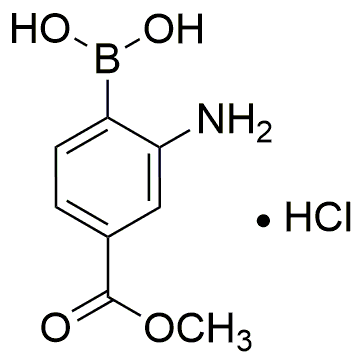2-Amino-4-(methoxycarbonyl)phenylboronic acid hydrochloride is widely utilized in research focused on:
- Pharmaceutical Development: This compound serves as a key intermediate in the synthesis of various pharmaceuticals, particularly in the development of drugs targeting cancer and diabetes.
- Bioconjugation: It is used in bioconjugation processes, allowing researchers to attach biomolecules to surfaces or other compounds, enhancing drug delivery systems.
- Material Science: The compound is applied in the creation of advanced materials, such as sensors and catalysts, due to its unique boronic acid properties that facilitate chemical bonding.
- Analytical Chemistry: It plays a significant role in analytical methods, particularly in the detection of sugars and other biomolecules, improving the accuracy of various assays.
- Organic Synthesis: This chemical is a valuable reagent in organic synthesis, enabling the formation of complex molecules through cross-coupling reactions, which is essential in the development of new materials and compounds.
General Information
Properties
Safety and Regulations
Applications
2-Amino-4-(methoxycarbonyl)phenylboronic acid hydrochloride is widely utilized in research focused on:
- Pharmaceutical Development: This compound serves as a key intermediate in the synthesis of various pharmaceuticals, particularly in the development of drugs targeting cancer and diabetes.
- Bioconjugation: It is used in bioconjugation processes, allowing researchers to attach biomolecules to surfaces or other compounds, enhancing drug delivery systems.
- Material Science: The compound is applied in the creation of advanced materials, such as sensors and catalysts, due to its unique boronic acid properties that facilitate chemical bonding.
- Analytical Chemistry: It plays a significant role in analytical methods, particularly in the detection of sugars and other biomolecules, improving the accuracy of various assays.
- Organic Synthesis: This chemical is a valuable reagent in organic synthesis, enabling the formation of complex molecules through cross-coupling reactions, which is essential in the development of new materials and compounds.
Documents
Safety Data Sheets (SDS)
The SDS provides comprehensive safety information on handling, storage, and disposal of the product.
Product Specification (PS)
The PS provides a comprehensive breakdown of the product’s properties, including chemical composition, physical state, purity, and storage requirements. It also details acceptable quality ranges and the product's intended applications.
Certificates of Analysis (COA)
Search for Certificates of Analysis (COA) by entering the products Lot Number. Lot and Batch Numbers can be found on a product’s label following the words ‘Lot’ or ‘Batch’.
*Catalog Number
*Lot Number
Certificates Of Origin (COO)
This COO confirms the country where the product was manufactured, and also details the materials and components used in it and whether it is derived from natural, synthetic, or other specific sources. This certificate may be required for customs, trade, and regulatory compliance.
*Catalog Number
*Lot Number
Safety Data Sheets (SDS)
The SDS provides comprehensive safety information on handling, storage, and disposal of the product.
DownloadProduct Specification (PS)
The PS provides a comprehensive breakdown of the product’s properties, including chemical composition, physical state, purity, and storage requirements. It also details acceptable quality ranges and the product's intended applications.
DownloadCertificates of Analysis (COA)
Search for Certificates of Analysis (COA) by entering the products Lot Number. Lot and Batch Numbers can be found on a product’s label following the words ‘Lot’ or ‘Batch’.
*Catalog Number
*Lot Number
Certificates Of Origin (COO)
This COO confirms the country where the product was manufactured, and also details the materials and components used in it and whether it is derived from natural, synthetic, or other specific sources. This certificate may be required for customs, trade, and regulatory compliance.


